Johann Georg Paschen, "Vollstandiges Ring-Buch", 1659
Notes on the Vollstandiges Ring-Buch
English translation by , c/o "The Dragon Preservation Society" November 2000
Translator's notes
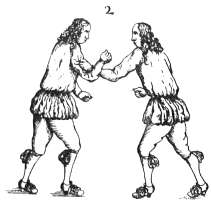 This is an interesting little 17th century wrestling manual, with focus on unarmed defence, and surprisingly complete in the types of techniques covered. It is also boringly repetitious and the explanations are not extraordinarily clear. The clarity is not improved by a paragraph numbering scheme that doesn't match the picture numbers, and the hard to read, fraktur-style typeface. I have omitted the paragraph numbering as I found it more confusing than helpful. The original has the pictures grouped, I have placed them with the relevant paragraphs.
This is an interesting little 17th century wrestling manual, with focus on unarmed defence, and surprisingly complete in the types of techniques covered. It is also boringly repetitious and the explanations are not extraordinarily clear. The clarity is not improved by a paragraph numbering scheme that doesn't match the picture numbers, and the hard to read, fraktur-style typeface. I have omitted the paragraph numbering as I found it more confusing than helpful. The original has the pictures grouped, I have placed them with the relevant paragraphs.
The work is divided in a first part, an other part, and a third part.
Most techniques have an inwendig and auswendig variant, the illustrations annoyingly show left and right versions for one variant, but don't show the other variant at all. I have translated these terms as inwards and outwards, for lack of better alternatives. Inwendig seems to mean mostly that the technique happens between your or his arms, and auswendig, outside of the arms, sometimes auswendig seems to mean from the center outwards, though, so the terms or at least my translation is not very consistent.
I left the latin words like Adversarius (opponent) from the original.
This translation is based on the version included in "Chronik alter Kampfkunste", Weinmann, Berlin, 1997 (ISBN 3 87892 031 8). My notes are in square brackets [like this].
This translation is dedicated to the virtue of generosity.
This translation was published in the Journal of Western Martial Arts
Note: Click here for details on registering with AEMMA and obtaining your Online Library electronic card.
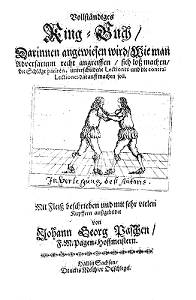 |
1.0 Translation of the Title Page Vollstandiges
Ring-Buch Wherein is shown how to correctly come to grips with Adversarium, to get free from holds, to parry blows, different Lectiones and the contra-Lectiones that apply to them. Described with care and illustrated with a very many coppers
by
Johann Georg Paschen
F.M. Pagen-Hoffmeistern |
The high-honorable [Hochwurdige, Durchlauchtigen, Hochgebornen]sovereign and lord,
Herrn Augusten dem Andern Hertogen zu Sachsen, Julich, Cleve und Berg
Landgrafen in Thuringen, Marggrafen zu Meissen, auch Oder und Nieder Lausis
Grafen zu der Marck, Ravensberg und Barbn
Herrn zum Ravenstein, etc [it says etc. in the original!]
Dom-Provsten zu Magdeburg Seinem Enddigsten Fursten und Herrn accept this from your most humble servant,
Johann Georg Pascha
1659 [this date is in a non-matching type and seems to be added later]
|
| To the gentle reader Wrestling ['Ringen'] is a useful exercitium, and well-known history shows that it was practiced by our forefathers not only for fun, but also in earnest, because it not only improves the condition of the whole body, but so also a weaker person can, by knowledge of this science, and fully trained therein, defend himself against a stronger one, and resist him. As high as it was esteemed by our forefathers, so little is it known in our time, and these days everyone relies on their size and strength, yet they feel in danger when confronted by a smaller man trained in wrestling. These circumstances have prompted me to bring some things to light in this print and coppers. Do not hesitate, lovers of wrestling, to willingly accept this little work by me, which I place in God's care.
|
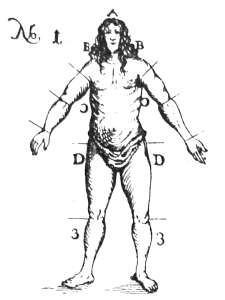 |
2.0 First Part Paschen begins his book by introducing the concepts of the strong, half-strong and weak as they relate to the parts of the human body. He then proceeds to elaborate on this principles in the "First Part" of the book, focusing entirely on the upper body and arms. The grapples and counters are oriented towards the hands, wrists and upper arms as depicted in the illustration beginning this part. An unusal aspect of this part includes an illustration and brief discussion about when an adversary decides to throw a jar at you and at which point you must protect yourself by covering your face with your forearms cross-wised as depicted in illustration #9. |
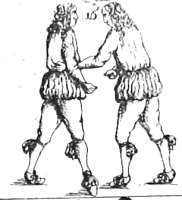 |
3.0 The Other Part This part of paschen's book now focuses on the mid-section of the human body, depicting grips of the hips and waist areas. A few illustrations also depict gripping the throat and text that describe a counter to this. This section concludes with a more visceral description of counters that involve one striking the chin, pushing your thumbs into the throat, and striking the nose in order to break free of being gripped by your opponent. |
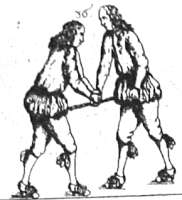 |
4.0 Third Part The last part of the book now covers some more creative counters to attacks such as head butts, striking the opponent's throat and knee breaking. This part also covers grips and counters to the lower portions of the body thus covering the entire human body and principles as described in the beginning of part 1. |
About the translator : Eli started practicing martial arts in 1992, and holds dan ranks in Chunen Butori Ryu, Iaido and Aikido (and HB ranking from Bill Mears soke, Hard Bastards America). During the last couple of years he has been interested in the study and reconstruction of old European martial techniques.
Credit: AEMMA wishes to thank , c/o "The Dragon Preservation Society" located in Belgium for his translation of Paschen's book and donating his work to be included in this presentation in this online library.
 This is an interesting little 17th century wrestling manual, with focus on unarmed defence, and surprisingly complete in the types of techniques covered. It is also boringly repetitious and the explanations are not extraordinarily clear. The clarity is not improved by a paragraph numbering scheme that doesn't match the picture numbers, and the hard to read, fraktur-style typeface. I have omitted the paragraph numbering as I found it more confusing than helpful. The original has the pictures grouped, I have placed them with the relevant paragraphs.
This is an interesting little 17th century wrestling manual, with focus on unarmed defence, and surprisingly complete in the types of techniques covered. It is also boringly repetitious and the explanations are not extraordinarily clear. The clarity is not improved by a paragraph numbering scheme that doesn't match the picture numbers, and the hard to read, fraktur-style typeface. I have omitted the paragraph numbering as I found it more confusing than helpful. The original has the pictures grouped, I have placed them with the relevant paragraphs. 


